#Mashpee Wampanoag Tribe of Massachusetts
Text
The Mashpee Wampanoag Tribe of Massachusetts stands in solidarity with Palestine during the Macy’s Thanksgiving Parade.
#Macy’s Thanksgiving Parade#Mashpee Wampanoag Tribe of Massachusetts#INDIGENOUS SOLIDARITY#from twitter
48 notes
·
View notes
Text
The New England-based Mashpee Wampanoag Tribe issued a statement after an unexpected demonstration involving a Palestinian flag took place on their float during the Macy’s Thanksgiving Day Parade in New York City on Thanksgiving morning.
In a still image shared by the tribe, someone in the background can be seen holding a small red, black, white, and green flag above their head.
The tribe didn’t identify who held up the flag but made it clear in a statement that they didn’t endorse the actions.
“It’s unfortunate that we are not focused on the beautiful display of our culture and history at the Macy’s Day Parade but rather on the actions of an individual tribal citizen. We want to make it very clear that the Tribe takes no stance on the conflicts overseas,” the statement read.
The tribe added, “Our Tribal Nation remains focused on the issues we face on our ancestral homeland. While we cannot speak for an individual’s actions, his actions were not a Tribal decision. Our governing tribal body, along with the other tribal citizens on the float, were not involved with his actions.”
The Mashpee Wampanoag Tribe, also known as the People of the First Light, has inhabited present day Massachusetts and Eastern Rhode Island for more than 12,000 years, according to their website.
In 2015, the federal government declared 150 acres of land in Mashpee and 170 acres of land in Taunton as the Tribe’s initial reservation, on which the Tribe can exercise its full tribal sovereignty rights.
The Mashpee tribe currently has approximately 3,200 enrolled citizens.
4 notes
·
View notes
Text
Keep your Thanks: Here’s the justice queer Native Americans really hunger for
The “first Thanksgiving” of 1621 between the Mashpee Wampanoag tribe and English Pilgrims at Plymouth, Massachusetts wasn’t as friendly as people think. In fact, many Native Americans feel that the occasion marked the start of 400 years of colonization and oppression. Some choose instead to observe the Friday after Thanksgiving as Native American Heritage Day, a day for recognizing Indigenous communities and their contributions to the nation.
Many present-day queer and Two-Spirit Native American activists are working to reclaim Indigenous lands, rituals, culture, and mental health. While some public events have begun reciting “land acknowledgments” — defined by NPR as “formal statements recognizing Indigenous communities’ rights to territories seized by colonial powers” — some see such statements as a well-intentioned but empty gesture, while others see them as a necessary first step towards restorative justice. On that road to justice, however, here are some of the political goals sought by Indigenous activists:
Related:
Watch this adorable gay Native American couple break barriers with a pow wow dance
The couple, who met on the pow wow circuit, have performed couples “sweetheart” dances, and are in awe of the warm responses they have received.
Legal recognition by federal and state governments
Get the Daily Brief
The news you care about, reported on by the people who care about you:
Subscribe to our Newsletter
Some tribes were forced into reservation territory and allowed sovereignty to oversee its land, businesses, and governance. But other tribes haven’t been legally recognized at all — something that severely limits tribe members’ ability to claim ancestral lands and receive financial restitution.
The federal government didn’t legally recognize the aforementioned Mashpee Wampanoag tribe until 2007, even though the tribe had existed for 12,000 years beforehand. Others continue to fight for legal recognition, even though their existence may already be well documented in historical records.
Restoring ancestral lands
Many tribes desire sovereignty over the lands that their ancestors once inhabited. This includes the Lakota Sioux, whose ancestors lived in the Black Hills, an area that now contains Mount Rushmore. The tribe oversaw the hills until the U.S. government violated a treaty, massacred their tribe members at Wounded Knee, and then carved the faces of four former U.S. presidents into the mountainside.
Predictably, many state and federal governments oppose restoring tribal lands, but it can be done. In 2015, the federal government pledged to restore 300 acres to the aforementioned Mashpee Wampanoag tribe, though former President Donald Trump’s Department of the Interior reversed the decision in 2018.
In 2009, the Wiyot people of California’s northern coast raised $106,000 to buy 1.5 acres on their ancestral land of Duluwat Island. The Eureka City Council voted to give the tribe 240 additional acres of island that the city had controlled. Around 2020, a United Methodist Church in Ohio also returned some land to the Wyandotte Nation.
This restoration can neither completely restore the ecological damage nor the lost relationships the tribes once had to their lands. But for many, it’s an important way to ensure that tribe members have a home and community dedicated to preserving their culture.
Preserving Indigenous knowledge
Although Indigenous communities only comprise an estimated 5% of the world’s population, they safeguard an estimated 80% of the planet’s biodiversity, according to the World Wildlife Federation. This safeguarding includes centuries-old practices of hunting, agriculture, and preservation that foster a respectful, reciprocal relationship with the land while providing sustainable alternatives to widespread deforestation, fossil fuel use, industrial over-farming, and species’ extinction. These are particularly important considering the increased natural disasters that have… http://dlvr.it/SzHt8r
0 notes
Text
UMass Boston Hosts the 2023 Tribal and Indigenous Health Summit
Tribal and Indigenous Leaders, Health Advocates, and Regional, State, and Local Representatives from across New England Gathered for the Inaugural Summit
On September 28, 2023, theInstitute for Community Inclusion (ICI) joined the Tribal and Indigenous Health Summit, led by the Massachusetts Department of Public Health.
Elizabeth Solomon, Elder of Massachusett Tribe at Ponkapoag, opened the Summit with a Tribal land acknowledgement, and welcomed attendees to her territory. Tribal Chair Brian Weeden of the Mashpee Wampanaog Tribe led the group in prayer. UMass Boston is on the traditional land of Massachusett people.
Throughout the day, Tribal and Indigenous leaders and others talked about mental health, the COVID-19 response, public health data, and substance abuse prevention, treatment, recovery, and harm reduction in Tribal and Indigenous communities.
Chairwoman Cheryl Andrew-Maltais of the Aquinnah Wampanoag Tribe of Gay Head addressed the audience in her Keynote speech:
“Miraculously, through our strength, courage, and resiliency, we’re here today to make positive changes in our Tribal communities’ health…By working together, we can build a better healthcare system for our people. By listening to us and our traditional cultural knowledge and incorporating our traditional medicinal practices, we can develop effective means to have better healthcare outcomes for our peoples.”

Cheryl Andrew-Maltais of the Aquinnah Wampanoag Tribe of Gay Head speaks at a podium with a banner that says, “Welcome. Massachusetts Tribal and Indigenous Health Summit 2023 Department of Public Health”
Several staff and faculty from ICI and the School for Global Inclusion and Social Development (SGISD) attended the Summit to learn about the rich history and strengths, challenges, and health threats facing Tribal and Indigenous communities across the nation. SGISD’s new Director Dr. Tiffany Donaldson expressed gratitude for sharing this space of learning with Tribal leaders:
“I learned so much through our work with Tribal leaders about cultural history and commitment to raising awareness about Native Health inequities and barriers to access. We will continue to partner with Tribal leaders and Indigenous communities to learn about what worked in the COVID pandemic and to promote health and wellness in areas of interest to Native people.”

Dr. Tiffany Donaldson looking to her side and smiling while talking to another attendee.
ICI and SGISD staff also learned about colonialism’s devastating impact on Native health. ICI Senior Research Fellow Dr. Susan Foley was honored to hear from tribal leaders, elders, Native doctoral students, Native researchers, Native mental health providers, Indian Urban Health, Indian Health Services, and Tribal and Indigenous People Serving Organizations. She shared about her learnings and ongoing commitment to advocacy:
“We heard calls for action unequivocally pointing to existing threats to tribal community well-being. As researchers in disability services, we will strongly advocate for more Native disability research capacity and support for Native researchers. We will continue to partner with Dr. Cedric Woods at the Institute for New England Native American Studies on the Native Equity in Employment and Recovery Project, with deep respect and friendship.”
Dr. Cedric Woods is the Director of UMass Boston’s Institute for New England Native American Studies (INENAS) and served on the planning committee for the Summit.
ICI Senior Research Associate Dr. Allison Taylor echoed these sentiments:
“It was a gift to experience the Campus Center Ballroom as a Native space and to be invited as a guest into that space, as we looked out on the land and waters of the Massachusett people. I was struck by the many examples of Native ingenuity, perseverance, and resilience to foster community health and well-being, within a context of ongoing erasure, inequity, and injustice.”
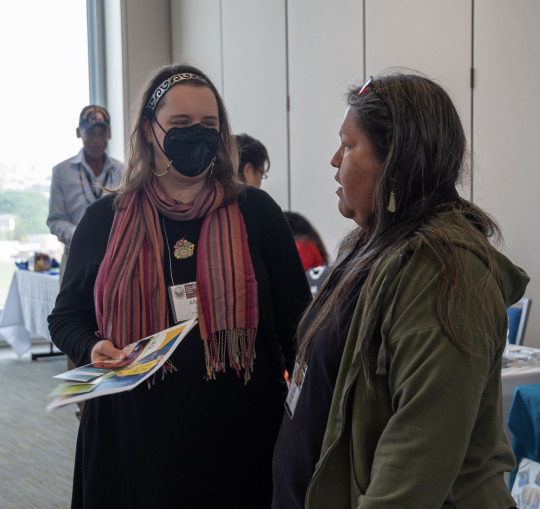
Allison Taylor, on left wearing a black mask, black dress, and colorful scarf, talks with Ella Blackowl, also from SGISD.
Two UMass Medical School PhD students who are Mashpee Wampanoag tribal members wrapped up the Summit with a brief tribal history and discussion of the impact of historical trauma. They also talked about how and why they decided to pursue Tribal health professions and what that will mean to the Tribal and Indigenous communities they represent.
Quinn Barbour, ICI’s Senior Marketing and Communications Manager, took photographs to commemorate this inaugural event.

James Beard Award-winning Chef Sherry Pocknett catered the event with Indigenous cuisine from her Wampanoag culture. Pocknett’s restaurant the Sly Fox Den Too is in Charlestown, Rhode Island.

On right, SGISD and INENAS’ Cedric Woods shakes hands with Dr. Robert Goldstein, Commissioner of the MA Department of Public Health.

Four Indigenous drummers, one holding a toddler, drum and sing as traditional dancers performed.

Indigenous dancers performed at the beginning of the event.
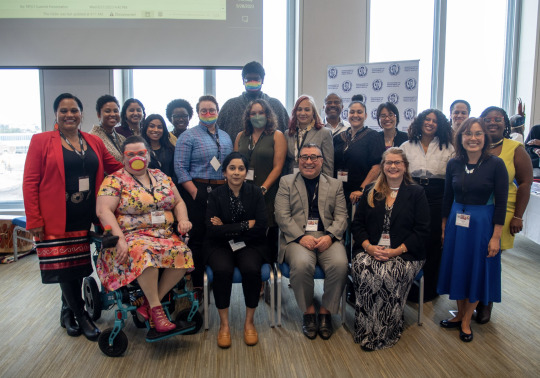
Staffers responsible for the event posed together for a group photo.
Information from this article was also obtained from Crystal Valencia's piece, "Chancellor, State Health Officials, Tribal Leaders Gather for Tribal and Indigenous Health Summit."
Indigenous Peoples' Day
This year, we observe Indigenous Peoples' Day on Monday, October 9. Observing Indigenous Peoples' Day is an act of solidarity with Native Peoples. Indigenous Peoples' Day has replaced Columbus Day in many locales. Christopher Columbus exploited and enslaved Taíno Peoples and appropriated their homelands. Observing Columbus Day celebrates colonialism and memorializes the demographic collapse, enslavement, and attempted erasure of Native Peoples in the Americas.
This October, take some time to learn more about indigenous people and cultures. Here are some additional resources to explore:
Native Reads: Books from Indigenous Communities
Living Nations, Living Worlds: A Map of First Peoples Poetry
Mashpee Wampanoag Tribe
Indigenous People’s Day: Red Lake Nation News
Praying Towns in Massachusetts: History
Association on American Indian Affairs
National Geographic: Native American imagery is all around us, while the people are often forgotten
New York Times: Lost Lives, Lost Culture: The Forgotten History of Indigenous Boarding Schools
Indian Law Resource Center: Ending Violence against Native Women
Walking in Two Worlds: Supporting the Two Spirit and Native LGBTQ Community
Workforce GPS: Native American Disability Resource Hub
Videos produced by the Native American Disability Law Center
Are you interested in learning more about UMass Boston’s Institute for New England Native American Studies? Contact Director Cedric Woods at [email protected].
Are you interested in learning more about UMass Boston’s Native American and Indigenous Studies Minor? Contact Director Maria John at [email protected] with questions about this academic program.
This blog includes excerpts from the 2021 SGISD blog, New UMass Mural Welcomes Native Students to UMass Boston Campus.
#Indigenous Peoples' Day#Institute for New England Native American Studies#INENAS#ICI#institute for community inclusion#school for global inclusion#school for global inclusion and social development#SGISD#UMass Boston#UMB
1 note
·
View note
Text
Exploring the Mashpee Wampanoag Tribe Museum (Article 6)
Amid the lush landscapes of Massachusetts, I was able to find a hidden gem on Cape Cod: the Mashpee Wampanoag Tribe Museum, a center of Native American art and heritage. I ventured into this cultural sanctuary to learn about the expressions of a non-majority culture that has deep roots in the region.
The museum's entrance invited me to step into a world that holds centuries of tradition. As I walked through, I was able to see things such as intricate beadwork, pottery, and vibrant textiles. You could tell that each piece had a story behind it and took time to be handcrafted in a quality manner.
The heart of the museum featured a gallery showing off contemporary Native American artwork. The pieces had many interesting ancient symbols that were an ode to Native American culture. Something that really stood out to me was a piece of art called "Honoring Our Ancestors," that was created by a local Wampanoag artist, which seamlessly blended traditional and contemporary elements, bridging the past and the present. This was cool to see as it combined the state of Native Americans now with their storied history.
As I explored the exhibits, I could easily see the deep reverence the Mashpee Wampanoag Tribe holds for the natural world. Their baskets, woven from native materials, pointed to an intimate relationship with the environment. It was a reminder that art isn't just a product—it's a reflection of a way of life, a connection to the land, and a celebration of harmony.
Exiting the museum, I reflected on the significance of my visit. The Mashpee Wampanoag Tribe Museum is more than a place of artifacts—it's a bridge that connects us to the rich heritage of the indigenous people who have called this land home for millennia. It's a reminder that acknowledging non-majority cultures isn't just an act of cultural preservation; it's an act of acknowledging the resilience, wisdom, and contributions of those who have been marginalized.
My encounter with the Native American art at the Mashpee Wampanoag Tribe Museum was an eye-opening experience that left me with a sense of admiration for the resilience of indigenous cultures.


0 notes
Text
Ex-Tribal Leader Ordered to Pay Nearly $210K in Bribery Case
BOSTON (AP) — The former leader of a Massachusetts Native American tribe sentenced to prison for accepting exercise equipment, a luxury hotel stay and other bribes from an architectural firm working with the tribe on a casino has to pay back nearly $210,000, a judge ordered.
Cedric Cromwell, former chair of the Cape Cod-based Mashpee Wampanoags, was sentenced to three years in prison in Boston…

View On WordPress
0 notes
Text
What They Really Ate on Thanksgiving
inedible - adjective - not able to be eaten (Google).
Thanksgiving has a tendency to creep up on you. And like any other holiday, once it is upon you, it stays for a few hours and then vanishes unlike the wild turkey (I'm talking the fowl here, not a hyper idiot or whiskey) of New Jersey that can decide to have a picnic in front of your car and refuse to relocate even when you lean on the horn. Most who celebrate the Pilgrims and Native Americans being united in good cheer for the first time up in Massachusetts in the early 1600s, adhere to their own set of traditions, which almost always includes a turkey (not a stubborn one, a defrosted Butterball). That being said, there is some controversy as to whether the original celebrants included the turkey on the menu.
Yesterday, as I was eating a hardboiled egg (a safe choice for any meal), I read TIME's "Her Tribe Fed the Pilgrims..." which is all about a Mashpee Wampanoag chef who is perpetuating the recipes of her people at her restaurant. The Mashpee Wampanoags were the friendly tribe who joined the refugees from England, some of whom just wanted to practice their religion sans any conflicts, which is nothing new even in this age. It is probably true that the natives chose the food for that initial dinner as the English have never been known for their cuisine although the last time I was in London, I did notice a vast improvement. What I am trying to impart here is that according to Sherry Pocknett, the Wampanoag cook featured in the essay, the vast, diverse party of diners probably didn't eat any turkey because the tribal people respected the "intelligence" of the turkey way too much to sample its edible wares. Instead, they most likely consumed the first two of which I consider to be inedible: venison (I don't eat deer because I feed them everyday on my front lawn; I try not to serve up animal friends to friends), duck (another pal) and various fish in addition to cornmeal, the latter most on the list being the only thing I have ever served on Thanksgiving. You must know of Jiffy corn muffin mix? Yes, that's it. The packaged cornmeal makes a great loaf of cornbread and only costs about a dollar.
I have to admit that I was a bit disappointed after reading the article. The acumen of the turkey must have gone down considerably over the centuries as I have never met a smart one. And it's a good thing because I enjoy eating turkey on Thanksgiving Day. I don't know what I'd do if I were forced to start thinking of them as friends.
Happy Thanksgiving to all who celebrate it!
#word-to-words, #slice-of-life, #literature, #blog, #blogging, #books, #editorial, #reading, #vocabulary, #history, #ReadersMagnet, #spilled thoughts, #good advice, #personal-essay, #writing community, #writing
0 notes
Text
November 25 2021 Barcelona

Happy Thanksgiving! This is the quintessential American holiday and the one many consider to be the most family-oriented. More people travel to be with family and friends for Thanksgiving than any other holiday.
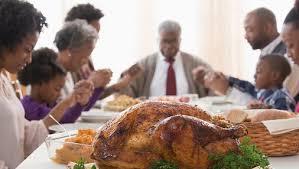




The theme is SHARING, CARING, and, for a lot of people, eating turkey with all the “trimmings”. The First Thanksgiving story remains controversial and the true story is quite different than many of the images which have saturated our culture and lodged themselves in our hearts and minds for centuries.



Every year there are reenactments of the traditional story all over the United States, and especially in Massachusetts, where The First Thanksgiving occurred.
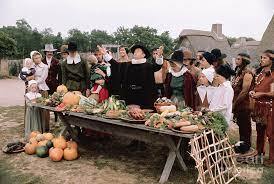


So let’s take a look at the traditional Thanksgiving story and then what’s been called the “true story “ of what happened to the Wampanaog People, also called the Mashpee Wampanaogs, who purportedly made that first Thanksgiving possible by sharing their food and knowledge of how to grow it and hunt with the Pilgrims, who were also among the first immigrants to the English colonies.
According to Wikipedia:
“Thanksgiving is a federal holiday in the United States, celebrated on the fourth Thursday of November. It is sometimes called American Thanksgiving (outside the United States) to distinguish it from the Canadian holiday of the same name and related celebrations in other regions. It originated as a day of thanksgiving and harvest festival, with the theme of the holiday revolving around giving thanks and the centerpiece of Thanksgiving celebrations remaining a Thanksgiving dinner.
The dinner traditionally consists of foods and dishes indigenous to the Americas, namely turkey, potatoes (usually mashed or sweet), stuffing, squash, corn (maize), green beans, cranberries (typically in sauce form), and pumpkin pie. Other Thanksgiving customs include charitable organizations offering Thanksgiving dinner for the poor, attending religious services, watching parades, and viewing football games. In American culture Thanksgiving is regarded as the beginning of the fall–winter holiday season, which includes Christmas and the New Year.

New England and Virginia colonists originally celebrated days of fasting, as well as days of thanksgiving, thanking God for blessings such as harvests, ship landings, military victories, or the end of a drought. These were observed through church services, accompanied with feasts and other communal gatherings. The event that Americans commonly call the "First Thanksgiving" was celebrated by the Pilgrims after their first harvest in the New World in October 1621.This feast lasted three days and was attended by 90 Wampanoag Native American people and 53 Pilgrims (survivors of the Mayflower). Less widely known is an earlier Thanksgiving celebration in Virginia in 1619 by English settlers who had just landed at Berkeley Hundred aboard the ship Margaret.
Thanksgiving has been celebrated nationally on and off since 1789, with a proclamation by President George Washington after a request by Congress. President Thomas Jefferson chose not to observe the holiday, and its celebration was intermittent until President Abraham Lincoln, in 1863, proclaimed a national day of "Thanksgiving and Praise to our beneficent Father.”

According to Native Hope:
“There are always two sides to a story. Unfortunately, when it comes to the history of Thanksgiving, generations of Americans have been taught a one-sided history in homes and schools.
The dominant cultural and historical story has been told from the perspective of the white colonialists who landed near Plymouth Rock in Massachusetts in 1620. In this version of the Thanksgiving story, the holiday commemorates the peaceful, friendly meeting of English settlers and the Wampanoag tribe for three days of feasting and thanksgiving in 1621.
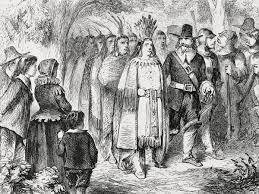
Every year, news outlets and social media are a-buzz with Thanksgiving themes.
There is little coverage of the fact that November is Native American Heritage Month or that the day after Thanksgiving, known to most as Black Friday, is Native American Heritage Day.
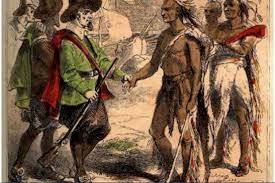
The mainstream version of the Thanksgiving story paints a picture of courageous, Christian settlers, braving the perils of the New World and with the help of some friendly Natives, finding a way to make a new life for themselves. In the days around Thanksgiving, many teachers focus on this happy story, helping students make American Indian headdresses out of construction paper and holding Thanksgiving reenactments in their classrooms.

Very few teachers realize that construction headdresses and school re-enactments create a lump stereotype that Native Americans all wear the same regalia. These school activities also encourage young students to think it is okay to wear culture as a costume. This makes it hard for students to recognize the diversity of Native American tribes and makes students believe it’s okay to mimic Native American traditional wear, without having an understanding of its spiritual significance.
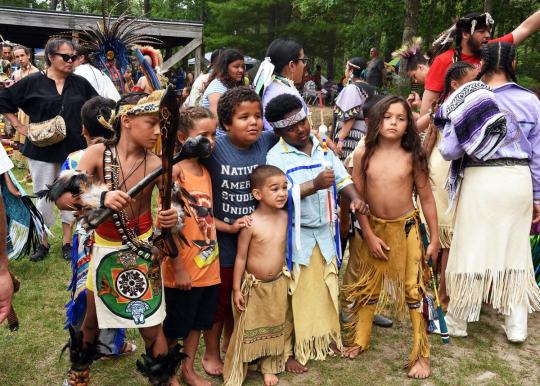

Very few teachers get a chance to tell students about the massacres of Native tribes like the Pequot that took place in the years that followed. They also do not mention that English settlers robbed Wampanoag graves and stole food from them in order to survive during their first years on this new continent.
Here’s a look at some of the reasons why Thanksgiving is a complex holiday, and one that all Americans should approach with greater sensitivity.

It’s important to know that for many Native Americans, Thanksgiving is a day of mourning and protest since it commemorates the arrival of settlers in North America and the centuries of oppression and genocide that followed.
Organized by the United American Indians of New England in 1970, the fourth Thursday in November (Thanksgiving) is recognized as the National Day of Mourning for Native Americans and their allies.

Many people gather at Cole's Hill in Plymouth for an organized rally and day of mourning on Thanksgiving. Here’s what they have to say about this choice to mourn:
“Thanksgiving day is a reminder of the genocide of millions of Native people, the theft of Native lands, and the relentless assault on Native culture. Participants in National Day of Mourning honor Native ancestors and the struggles of Native peoples to survive today. It is a day of remembrance and spiritual connection as well as a protest of the racism and oppression which Native Americans continue to experience.”



While some Native Americans have chosen to reject the Thanksgiving holiday entirely, many embrace the positive messages of the holiday and choose to put aside thoughts about the complex history of this day.
This is because the idea of giving thanks is central to Native heritage and culture, and in this way, Thanksgiving is simply a chance to appreciate the good things of life like family, community, and the riches of the land. Long before settlers arrived, Native tribes were celebrating the autumn harvest and the gift of Mother Earth’s abundance. Native American spirituality, both traditionally and today, emphasizes gratitude for creation, care for the environment, and recognition of the human need for communion with nature and others.
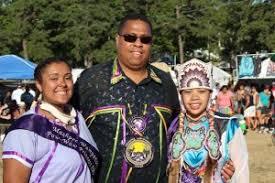
Thanksgiving as a holiday originates from the Native American philosophy of giving without expecting anything in return. In the first celebration of this holiday, the Wampanoag tribe not only provided the food for the feast, but also the teachings of agriculture and hunting (corn, beans, wild rice, and turkey are some specific examples of foods introduced by Native Americans).
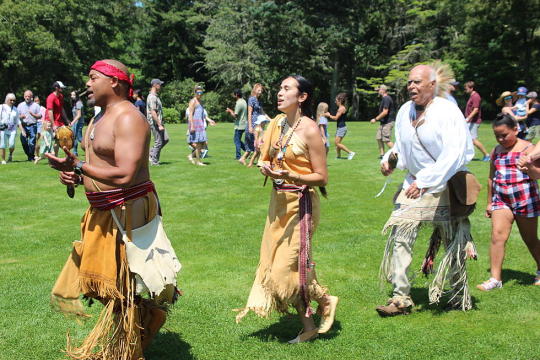
Now, regardless of the origin of the day, many Native Americans will gather with friends and family and use the day to eat good food (many of the classic Thanksgiving dishes are inspired by indigenous foods) and give thanks.

Steven Peters, a Wampanoag Tribe spokesman, was asked about his views on Thanksgiving and the fact that most people still gather to eat turkey and give thanks. Here's what he had to say:
"I think it's great. My ancestors had 4 harvest festivals throughout the year. Gathering with family, enjoying our company, sharing our blessings, and giving thanks for all that we have is a good thing. I say have more thanksgiving events throughout the year. I also ask that you take a moment in that day to remember what happened to my people and the history as it was recorded and not the narrative that we had been given in the history books."

I was happy to have the chance today to speak with my friend Eva’s high school English classes at Instituto Icaria and also to an English class of her friend Javier. On my way into the building I took some photos of some entries in a photographic exhibition.





It was great fun to speak English with Eva’s and Javier’s students! They had a LOT of questions about Thanksgiving, U.S. history, and the rights of Indigenous Peoples, as well as other questions about American culture and politics. I was honest and straightforward with them. I shared a lot of the information I’ve shared in this blog to help them understand the perspective of the Native Americans. I learned a lot from them and I hope they learned from me, too. After the classes concluded Eva’s boyfriend, Lluis, drove us, so I got to meet him and invite him to join us for the belated Thanksgiving dinner on Sunday that I’ll be making for Eva and her kids.
0 notes
Text
Native Groups Seek to Repair Lands Damaged by Colonization : Inside US
Native Groups Seek to Repair Lands Damaged by Colonization : Inside US
By PHILIP MARCELO, Associated Press
KINGSTON, Mass. (AP) — Asa Peters marched into a thicket of Japanese knotweed in the woods of coastal Massachusetts this month and began steadily hacking the towering, dense vegetation down to size.
The 24-year-old member of the Mashpee Wampanoag tribe was among a cadre of volunteers rooting out invasive species and tending to recently planted native…

View On WordPress
0 notes
Photo

Mashpee Wampanoag tribe work to restore indigenous ecosystem of Massachusetts Are you interested in this story? Download the Balanced News Summary app to read more! Link in our bio. For breaking news and updates follow @balancednewssummaryapp #BalancedNewsSummary #Alert, #Article, #Cybernews, #Doyourownresearch, #F7C3298EC3255A67817C722Fb68A112E, #Fnc, #FoxNews, #FoxNewsTopicAssociatedPress, #FoxNewsUs, #FoxNewsUsEnvironmentLand, #FoxNewsUsUsRegionsNortheastMassachusetts, #Freespeech, #Freethought, #Fyi, #Headlines, #Insidestory, #Instapolitics, #Nationalnews, #Newapp, #Newsflash, #Politicalnews, #Politics, #Realnews, #Todaynews, #Topstories, #Truthistruth, #Truthmovement, #Truthteller, #Worldwidenews
#alert#article#cybernews#doyourownresearch#f7c3298e-c325-5a67-817c-722fb68a112e#fnc#Fox News#fox-news/topic/associated-press#fox-news/us#fox-news/us/environment/land#fox-news/us/us-regions/northeast/massachusetts#freespeech#freethought#fyi#headlines#insidestory#instapolitics#nationalnews#newapp#newsflash#politicalnews#Politics#realnews#todaynews#topstories#truthistruth#truthmovement#truthteller#worldwidenews
0 notes
Photo


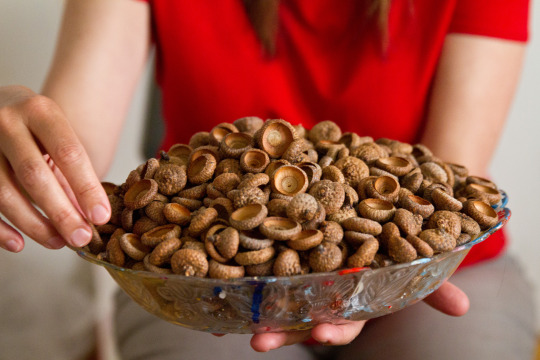

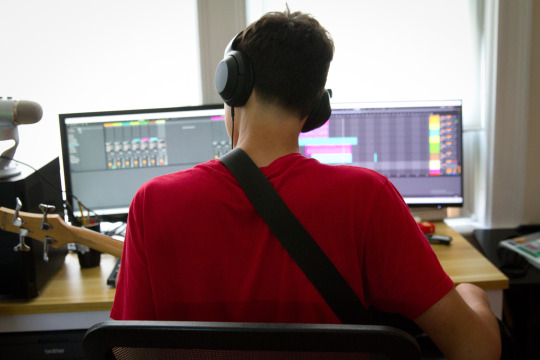
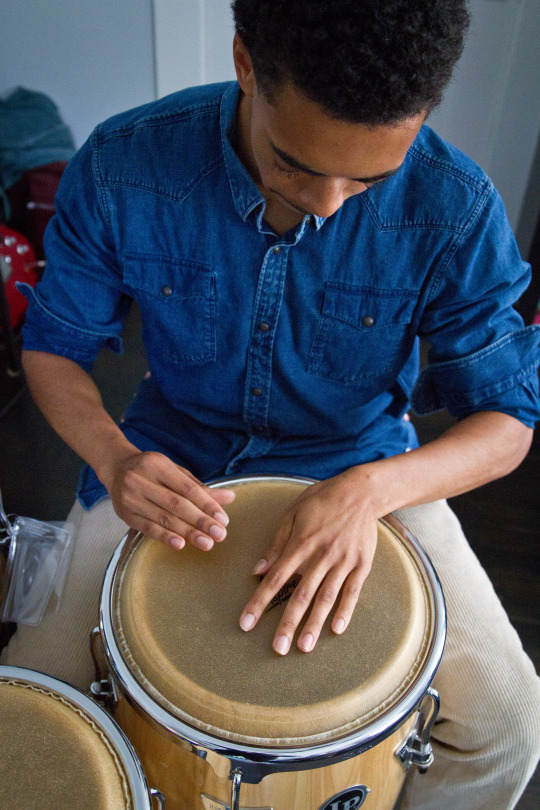

These are photographs of some Native Youth Artists in Massachusetts who use digital, visual and performing art to retain and express their culture and to nurture their well being. They are representatives of various tribes including the Mashpee and Aquinnah Wampanoag, Nipmuc, Comanche and other indigenous tribes across the country and from Central and South America.
0 notes
Text
#Mashpee Wampanoag tribe#bureau of indian affairs#breaking of treaties#racism#native peoples#indigenous peoples#native americans#Massachusetts
5 notes
·
View notes
Text
Shalom and happy Thanksgiving, please consider donating to the mashpee wampanoag tribe in Massachusetts, a tribe that was one of the first to be pushed out of their lands and are often in the fake folklore of the history of Thanksgiving. Currently Massachusetts does not recognize the mashpee wampanoag as a tribal nation and has been trying to steal even more of their land and destroying their culture
19K notes
·
View notes
Link
I have not seen news of this traveling outside locals in Massachusetts, so if you have a minute, please, please read the following message from the Mashpee Wampanoag Tribe (yes, the one you learned about in elementary school for your Thanksgiving play), whose lands are being taken out of trust, under the radar, in the midst of a global crisis. We have reason to believe that this is directly related to Donald Trump’s personal grudges against casinos not run by his cronies.
I encourage everyone to sign this petition, contact your politicians, and spread the word to prevent this injustice.
More information available here, and at the official Mashpee Wampanoag site.
Thank you.
--------------------------------------
At 4:00 pm today -- on the very day that the United States has reached a record 100,000 confirmed cases of the coronavirus and our Tribe is desperately struggling with responding to this devastating pandemic -- the Bureau of Indian Affairs informed me that the Secretary of the Interior has ordered that our reservation be disestablished and that our land be taken out of trust. Not since the termination era of the mid-twentieth century has a Secretary taken action to disestablish a reservation.
Today's action was cruel and it was unnecessary. The Secretary is under no court order to take our land out of trust. He is fully aware that litigation to uphold our status as a tribe eligible for the benefits of the Indian Reorganization Act is ongoing.
It begs the question, what is driving our federal trustee's crusade against our reservation?
Regardless of the answer, we the People of the First Light have lived here since before there was a Secretary of the Interior, since before there was a State of Massachusetts, since before the Pilgrims arrived 400 years ago. We have survived, we will continue to survive. These are our lands, these are the lands of our ancestors, and these will be the lands of our grandchildren. This Administration has come and it will go. But we will be here, always. And we will not rest until we are treated equally with other federally recognized tribes and the status of our reservation is confirmed.
I will continue to provide updates on this important issue in the coming days as we take action to prevent the loss of our trust status.
Kutâputunumuw;
Chairman Cedric Cromwell
Qaqeemasq (Running Bear)
3K notes
·
View notes
Photo


#StandwithMashpee against “disestablishing” the Mashpee Wampanoag reservation amid a pandemic. Fires are lit May 3rd, official hearing in D.C. is May 7th.
Light your candle or fire, let it burn 1-4 days, and post a picture with the hashtag #StandWithMashpee on twitter & other social media-
Sign the Petition: https://mashpeewampanoagtribe-nsn.gov/standwithmashpee
Call your Senator: Demand the passage of HR 312 (This bill reaffirms the Mashpee Wampanoag Tribe reservation as trust land in Massachusetts.)
Donate directly: https://mashpeewampanoagtribe-nsn.gov/donations
1K notes
·
View notes
Text
I know I have Native followers, although none that I know of from this tribe.
How can we help?
Non-Native followers: YOU BEST READ AND REBLOG THIS. Long, sustained publicity allowed the Standing Rock Sioux to make their case and win the safety of their rightful land. Publicly shaming these officials is the best tool we have until the Wampanoag outline how they want to move forward. We must be their allies and lift up their cause to help them protect their land.
White followers: this goes triple for you. It’s uncomfortable as hell, but in matters like this, we SHOULD be uncomfortable, and use that discomfort to take action rather than rest in complacency. “He who remains neutral in situations of injustice has chosen the side of the oppressor.” —Desmond Tutu
1K notes
·
View notes